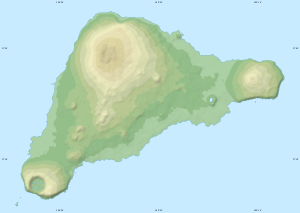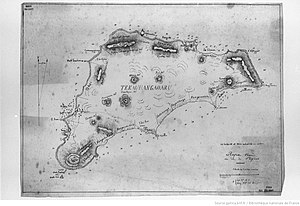Anakena
| Anakena | ||
|---|---|---|
|
Anakena on Easter Island |
||
| Waters | Pacific Ocean | |
| Land mass | Easter island | |
| Geographical location | 27 ° 4 ′ 20 " S , 109 ° 19 ′ 27" W | |
|
|
||
| width | 460 m | |
| depth | 320 m | |
| surface | 3 ha | |
|
Anakena was one of 20 inhabited coastal districts, between Hangaoteo in the west and Ovahe in the east |
||
Anakena is a bay on the north coast of Easter Island . Legend has it that this is where Hotu Matua , the mythical founding father of the Easter Island people, landed and founded a settlement. This settlement was the nucleus for the settlement of Easter Island.
geography
At the end of the 500 m diameter bay on the north coast is a small white sandy beach, next to the smaller Ovahe beach one kilometer further east, it is the only one on Easter Island. It is an ideal landing spot for shallow canoes. In this respect, the legend of Hotu Matua probably contains a real core. Today the area is covered with a small coconut palm grove. The coconut palm was not originally found on Easter Island; today's palm trees were only planted in the 20th century.
history
Anakena once belonged to the territory of the powerful and influential Miru tribe, who provided the Ariki Mau, the spiritual leader of Easter Island, and traced their descent directly to Hotu Matua. At the bay are two large, now restored Ahu (ceremonial platform ), the Ahu Nau Nau with seven Moai and the Ahu Ature Huki with a standing stone figure. One can therefore assume that there was an important settlement here in classical times.
At Anakena there are two archaeologically tangible relics, remains of dwellings which, according to the tradition of the Rapanui, can be associated with Hotu Matua: a cave dwelling (Hotu Matua's Cave) and foundation parts of a Paenga house (Hotu Matua's House).
Hotu Matua's cave is about 200 m southwest of the beach. The Rapanui claim that this is where Hotu Matua lived after landing on Easter Island until his house was completed. The cave is located in a natural channel along with other caverns. Arne Skjølsvold from Thor Heyerdahl's Norwegian Easter Island expedition in 1952/53 examined the only 6 m deep, low cave, the entrance of which was artificially narrowed with stone layers. He found a spearhead made of obsidian ( mataa ), which he dated to the 17th or 18th century, as well as some remains of European trade products. He did not find any signs of early residents.
From Hotu Matua's house near the Ahu Nau Nau, only a single row of worked basalt foundation stones has been preserved (for the construction method → Paenga house ). The location suggests an exceptionally large, north-south-oriented building. However, the entire west side is missing. Skjölsvold suspected that the plant was never completed. During excavations inside, he did not find any household effects or other relics, so Hotu-Matua's house may never have been inhabited.
However, further inland there are remains of numerous residential buildings, earth ovens and enclosed gardens, which suggest a dense settlement. They prove that the first settlement on Easter Island could have actually been in Anakena Bay.
Today Anakena Beach is occasionally used as a bathing place for tourists. Immediately behind the beach is a public picnic area with wooden tables and benches.
Anakena was one of the locations in the 1994 Hollywood film Rapa Nui, produced by Kevin Costner - Rebellion in Paradise .
Individual evidence
- ^ Thor Heyerdahl and Edwin N. Ferdon: Reports of the Norwegian Archaeological Expedition to Easter Island and the East Pacific . Volume 1, London 1965, pp. 273-276.
- ↑ Terry L. Hunt: No Collapse on Easter Island? , Spectrum of Science, December 2006, pp. 38–46.


